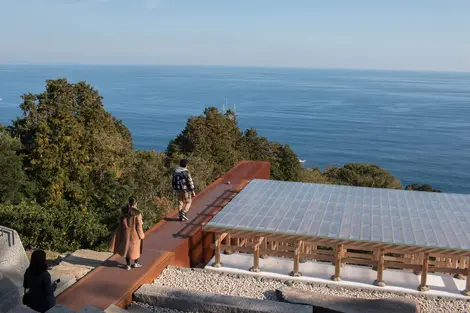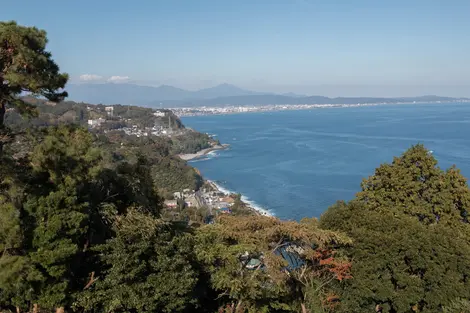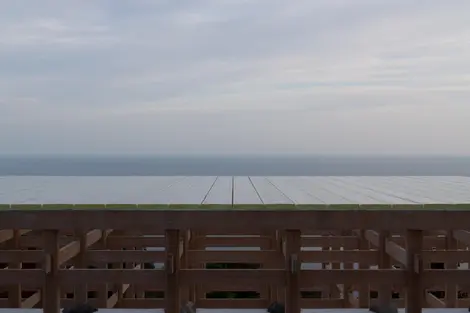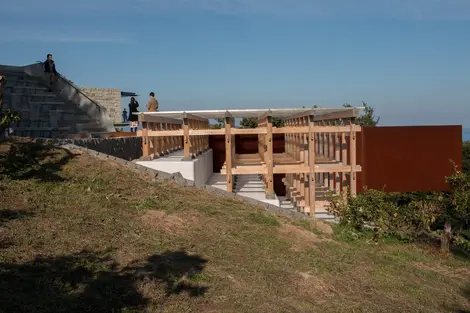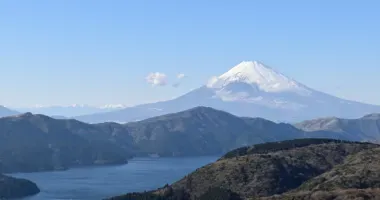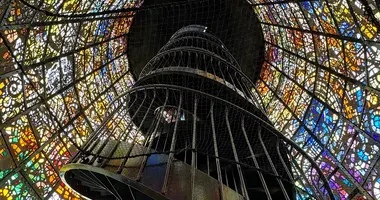Enoura Observatory 江之浦測候所
- Published on : 28/12/2018
- by : S.V.
- Youtube
Exactly under the sun
Enoura Observatory, the art complex of the Odawara Art Foundation, opened in October 2017. Designed by contemporary art artist Hiroshi Sugimoto, this place of total art offers a sensory and spiritual experience quite unique.
The Odawara Art Foundation
Promote Japanese culture and arts (theater, painting, sculpture, music); this was Hiroshi Sugimoto 's goal when he established the Odawara Art Foundation in December 2009.
Born in Tokyo in 1948, Sugimoto, although living in New York since 1974, chose the city of Odawara to host his foundation and his equipment. A location that owes nothing to chance. A childhood memory of the protean artist , internationally recognized for his photographs, architectural projects, sculptures, monumental installations and theatrical productions, is the starting point of this new artistic adventure which has occupied him for 10 years now.
Sugimoto thus recounts at leisure why Sagami Bay in Odawara holds such a special place for him. During a train journey between Atami and Odawara, he remembers being deeply marked by the appearance of the Pacific Ocean as a horizon line at the exit of a tunnel. The darkness had suddenly given way to a radiant sun projecting its sparkling reflections on the surface of the water. This incomparable beauty then made him aware of his own existence .
An existential question
By inaugurating the Enoura Observatory, Sugimoto intends to transmit the essence of Japanese culture to the widest possible audience. The vast complex is a cultural and artistic center with, among other things, two theater stages, conference rooms, an art gallery, a tea house; each structure of the site being a work in its own right. But it is not yet another institution offering only the exhibition of splendid collectibles.
Enoura Observatory, a total work of art , is the embodiment of Sugimoto's existential philosophy. The places thus invite the visitor to wonder about the passage of time and the importance of transmission to future generations. By using traditional construction techniques and old materials (thousand-year-old cedar, re-use of rocks excavated during construction), the artist makes the visitor aware of the history of past art.
He then invites everyone to enjoy the present moment by appreciating the extraordinary beauty of the bay and the panoramic view offered on the Boso peninsula and the island of Oshima. Not content with that, it also leads the visitor to question the interaction between man and nature and the future of places in the decades to come.
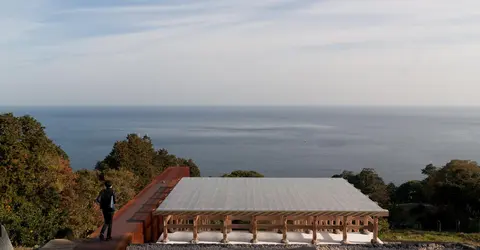
The view of Sagami Bay is breathtaking
LWYang
The reign of the solar star
Notable amenities include the Uchôten or "listen to the rain" tea house which is a perfect reinterpretation of the Taian tea house in Kyoto, designed by tea master Sen no Rikyu (1522-1591). The only departure from the original design is the reuse of the tin roof of an Odawara barn to cover the tea house. The sound of rain falling on the sheet metal earned him his poetic surname. But the construction of most of the observatory's structures was largely guided by the annual movement of the sun.
Hiroshi Sugimoto has given a special place to the equinoxes and solstices which have punctuated the passage of the seasons since the dawn of time. He built two ocean-view galleries to take full advantage of the solstices: the Summer Solstice Worship Gallery, a 100-meter-long glass and stone gallery, and the Winter Solstice Tunnel , made entirely of metal and measuring 70 meters. During the solstices, the sun's rays penetrate and illuminate the two structures.
The optical glass theater stage adjacent to the metal tunnel also receives the sun's rays on the morning of the winter solstice and shines with light. In addition, this glass top rests on a cypress frame and pillars, in the architectural style of kake-zukuri made famous by the Kiyomizu-dera temple in Kyoto.
During theatrical performances, from the amphitheater facing it, the stage seems to float on the surface of the sea. The spring and autumn equinoxes are celebrated by a second Noh scene behind which the sun rises. On the latter, entirely in stone, the actors perform only before dawn. The visit experience varies according to the location of the solar star, it is up to you to choose the ideal date for your visit!
To go further: Nô theatre, a subtle representation of human emotions
Address, timetable & access
Address
Phone
+81 (0)465-42-9170Timetable
From Nebukawa Station, take the free shuttle to the observatory.Price
Tickets reserved in advance: 3,000 yen (24 €) - Tickets purchased on site: 3,500 yen (28 €) - Reservation recommended.Access
Two admissions per day: morning (10:00 a.m. to 1:00 p.m.) and afternoon (1:30 p.m. to 4:30 p.m.). Closed on Tuesday, Wednesday, during the New Year holidays. The number of visitors is limited to each admission. Due to the unique nature of the venues and for safety reasons, visitors must be 12 years of age or older.Website
https://www.odawara-af.com/en/





